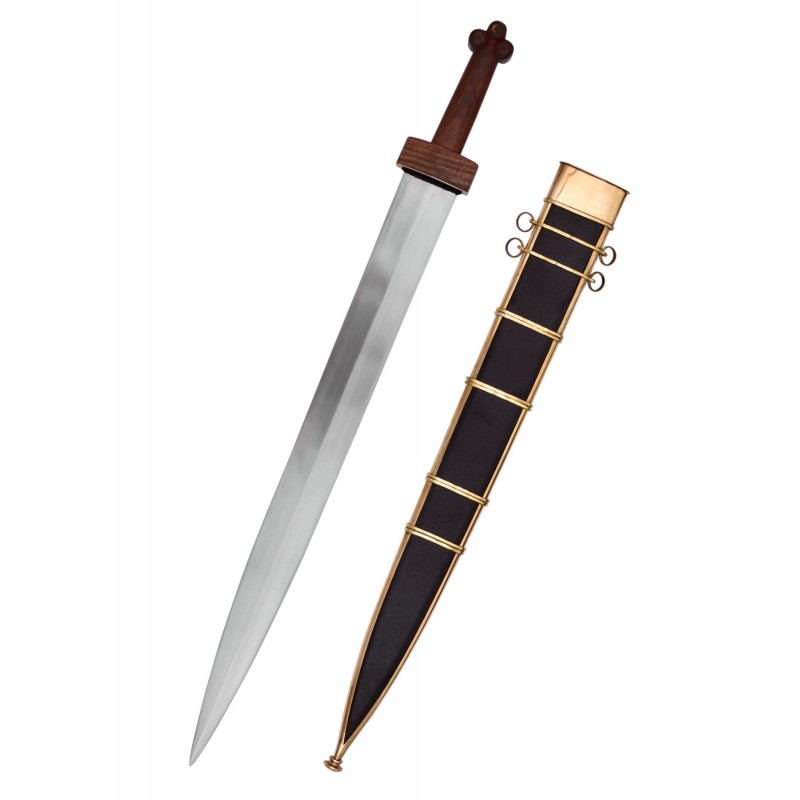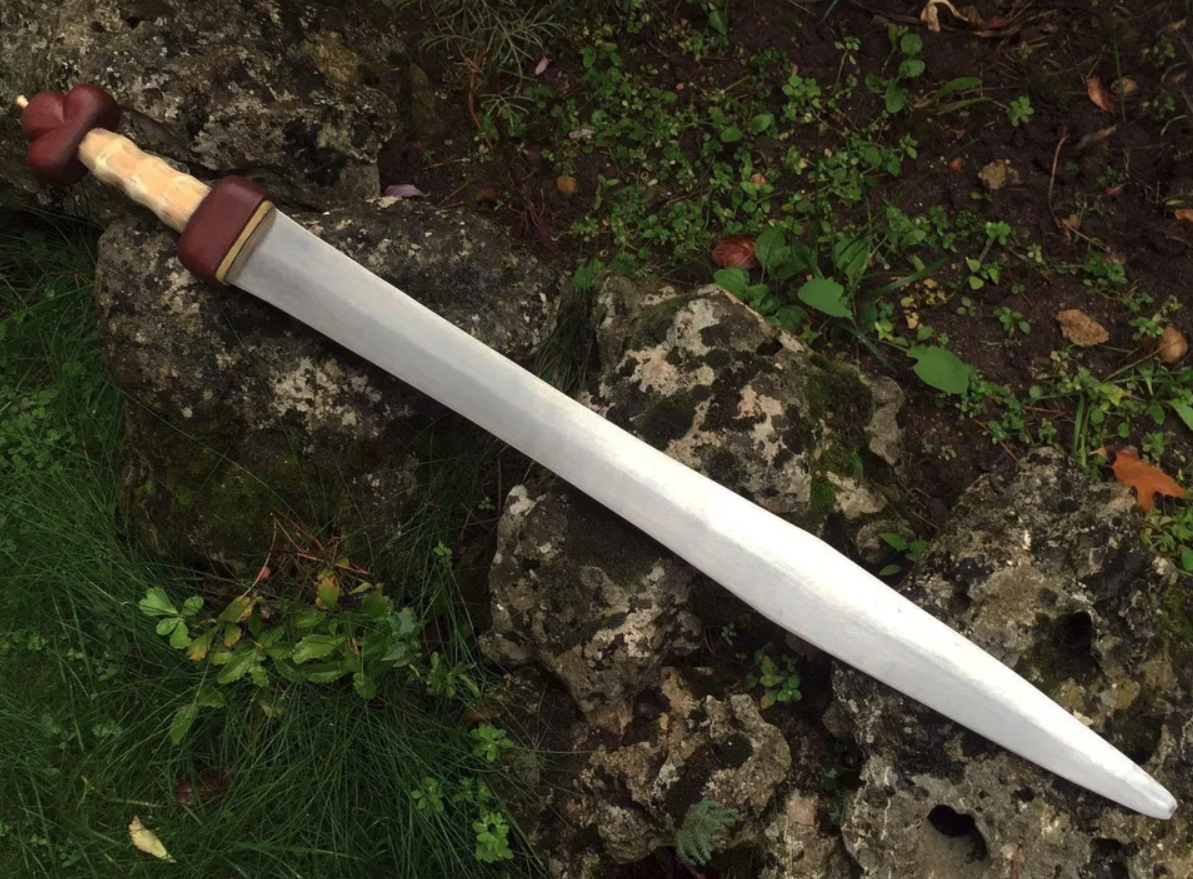
Roman Gladius of the Republican Roman period Gladius hispaniensis 3rd Century B.C. Roman
The full name of the sword, gladius Hispaniensis (Latin for "Hispanic sword") points to this origin.. As the original military camp turned into the city of Mainz, sword making increased as more sword craftsmen flocked to the city in search of acquiring wealth from their trade. The Mainz blade design kept the curvature of the original.

Compra de una Reproducción de Gladius Hispaniensis Tipo Delos
The earliest examples of the gladius Hispaniensis that we have in clearly Roman contexts are two early second-century swords from Grad near Šmihel, Slovenia and they are neat examples of the type. 4 The blades are 62.2 and 66cm, which is to say at the longer end of the range for their Iberian forebears, but that will be typical for the type as the blade-lengths for the gladius Hispaniensis.

Gladius Hispaniensis, Mainz style
THOUSANDS of videos more at 🦅⚡ https://www.youtube.com/channel/UCzmVYmxIvkrjmBNgLJMJYEw/videosENDLESS playlists at 🦅⚡ https://www.youtube.com/@wol.im.hiut..

Gladius Hispaniensis Completed Crown
The original gladius Hispaniensis may have been nearly as long as a Roman cavalry sword but was reduced to about 25-27 inches in length by the early imperial era. The point was also more tapered.

Ancient Roman High Carbon Steel Gladius Hispaniensis With Authentic Scabbard eBay
The Roman carries a gladius hispanicus: "Scu/o pedes/n° el gladio rius, Fr. lOb hispanico cinclUs [se.Tirus Manlius] conrra Gallum cinsririt. alque /fispanlco gladio] pectus /uJ.#sil H. The.

Iconic Weapons Gladius Hispaniensis The Pensive Warrior
The gladius hispaniensis or Spanish short sword which originated in Iberia but was famously adopted by the Roman army. (Re-enactment display of Roman Army Tactics Scarborough Castle, UK). When republishing on the web a hyperlink back to the original content source URL must be included. Please note that content linked from this page may have.

Iconic Weapons Gladius Hispaniensis The Pensive Warrior
Definition: The original sword, taken from the Hispanic design, was the 27 inch short straight sword, which broadened towards the handle giving it a slight "wasp-waist" or "leaf-blade" curvature.. The blade The gladius is referred to by the following names the Gladius Hispaniensis, Mainz, Fulham, Pompeii and Gladius Graecus: The Gladius.

El Gladius Hispaniensis Blog
This replica's blade is rendered in 5160 steel, made by Mark Morrow. It closely replicates an original found at Smihel, Slovenia. This blade is at the upper end of both length and breadth spectrum for a Hispaniensis. The owner has hilted the blade in naturally harvested and hand-carved walnut and bovine shin-bone, with a simple brass shoulder.

FABRICACIÓN GLADIUS HISPANIENSIS Portal Historia Reenactment
This image shows the different major types of Roman gladius hispaniensis, the most well-known sword of the Roman army. The image shows the following gladius types: - Republican. When republishing on the web a hyperlink back to the original content source URL must be included. Please note that content linked from this page may have different.

The Flaxen Saxon Chronicles Gladius Hispaniensis
The gladius hispaniensis blade was circa 60-68 cm long, with the total sword being around 75-85 cm. The width of the blade was roughly 5 cm. Mainz gladius. The Mainz gladius came into use at the frontier during the early stages of the Roman Empire. It had a shorter and wider blade than the gladius hispaniensis, and ended in a triangular point.

Ancient Roman Gladius Hispaniensis Panther Wholesale
The original Hispanic sword, had a slight "wasp-waist" or "leaf-blade" curvature. It was used in the republic. The Mainz variety came into use on the frontier in the early empire.. Gladius Hispaniensis: Used from around 216 BC until 20 BC. Blade length ~60-68 cm (23.6 to 26.7 inches). Sword length ~75-85 cm (29.5 to 33.5 inches). Sword.

Gladius Hispaniensis Меч, Римский легион, Рим
For four centuries, the gladius was one of the defining weapons of Rome as both a republic and an imperial power. It emerged in the 3rd-century bce, as Rome sought tactical and technological innovations to counter Celtiberian and Carthaginian enemies. The sword was most likely derived from Spanish models, hence the historical name of its first.

Gladius Hispaniensis Handcrafted High Carbon Damascus Steel Decorative Battling Blades
Design & Effectiveness. The standard gladius Hispaniensis did not change very much over the years.Made from iron (with a few examples in Toledo steel) it had a straight blade of up to 65 cm (25 inches), pointed tip (mucro) and double edge.Polybius describes the sword thus, "It has an excellent point and a strong cutting edge on both sides, as its blade is firm and reliable" (Polybius 6.23.6-7.

Gladius Espadas romanas Espadas ⚔️ Tienda Medieval
Gladius ( Classical Latin: [ˈɡɫadiʊs]) is a Latin word properly referring to the type of sword that was used by ancient Roman foot soldiers starting from the 3rd century BC and until the 3rd century AD. Linguistically, within Latin, the word also came to mean "sword", regardless of the type used. Early ancient Roman swords were similar to.

Gladius Hispaniensis High Carbon Damascus Steel 28" Roman/ Gladius Battling Blades
Gladius Hispaniensis Timeline. Search Results. c. 250 BCE - c. 200 CE. Originally a Celtiberian weapon, the Gladius Hispaniensis was commonly used by Roman soldiers for more than four centuries. Timeline Search. Search through the entire ancient history timeline. Specify between which dates you want to search, and what keywords you are looking for.

Hispaniensis Gladius Sword High Carbon Damascus Steel 24" Gladiator Battling Blades
The original draft is lost, but this is not too serious a limitation because it will certainly have used the only adjective provided by this language (Iberikè), which does not provide, as already mentioned, the distinction between hispaniensis and hispanicus.. Quesada Sanz argues that 'the prototype of the gladius hispaniensis is a.